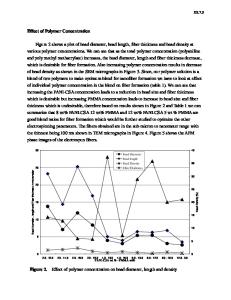Pb(Zr,Ti)O 3 nanofibers produced by electrospinning process
- PDF / 1,170,792 Bytes
- 6 Pages / 612 x 792 pts (letter) Page_size
- 55 Downloads / 403 Views
1129-V07-08
Pb(Zr,Ti)O3 nanofibers produced by electrospinning process Ebru Mensur Alkoy, Canan Dagdeviren and Melih Papila Faculty of Engineering and Natural Sciences, Sabanci University, 34956,Tuzla, Istanbul, Turkey ABSTRACT Lead zirconate titanate (PZT) nanofibers are obtained by electrospinning a sol-gel based solution and polyvinyl pyrrolidone (PVP) polymer, and subsequent sintering of the electrospun precursor fibers. The PVP content of the precursor solution is critical in the formation of the fully fibrous mats. Scanning electron microscope (SEM) is used to examine the morphology of the precursor fibers and annealed PZT nanofibers. The diameters of the precursor PZT/PVP green fibers have increased with the aging of the precursor solution along with an increase in the viscosity. The viscosity of 500 mPa results in successful fibrous mats, yielding green PZT/PVP fibers with a diameter of 400 nm. The fiber mats are then sintered at 700°C. X-ray diffraction (XRD) pattern of the annealed PZT fibers exhibits no preferred orientation and a pure tetragonal perovskite phase. Preparation of piezocomposites by infusion of epoxy into the nanofiber mat facilitates successful handling of the fragile mats and enables measurements of dielectric properties. INTRODUCTION PZT is the most widely used ferroelectric material in ultrasonic transducers, non-volatile random access memory devices, microelectromechanical devices, sensor and actuator applications due to its high dielectric constant, high electromechanical coupling coefficient, and large remnant polarization [1,2]. This material can be processed into various forms such as bulk ceramics, thin films and fibers depending on application area. PZT in fiber form is appealing because of its increased anisotropy, improved flexibility and strength over monolithic PZT ceramics. Micron-scale PZT fibers are usually incorporated into a polymer matrix to obtain smart piezocomposite structures [3]. They can also be used as individual fibers in novel actuator and sensor devices, such as energy harvesting and self-powered in-vivo medical devices, highfrequency transducers, non-volatile ferroelectric memory devices [4]. Nano-scale PZT fibers are also expected to find wide applications particularly in nano-electronics, photonics, sensors and actuators [5]. There are a few methods to obtain PZT in fiber form. Sol-gel, dicing of the bulk ceramic, and extrusion, for instance, are applied to produce PZT fibers typically in the micron scale [6,7,8]. Electrospinning technique has recently gotten attention because the fibers at micro- and even nanoscale can be produced by this method. Nano-scale PZT fibers have been also produced by electrospinning method [9,10,11]. Zhou et al. [12] have produced PZT nanofibers and found that these fibers exhibit significant reversible piezoelectric strains under applied electric field. The level of this strain was measured to be about 4.2% which is reportedly six times larger than that observed in thin films. The objectives of this study are to investigate th
Data Loading...











